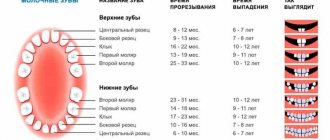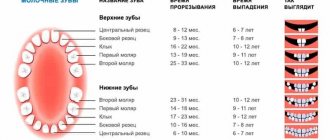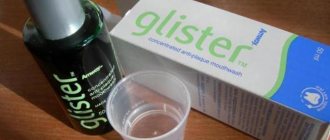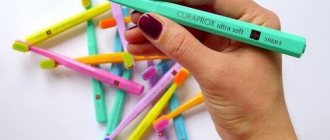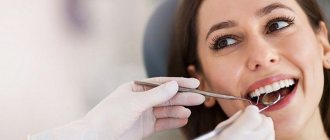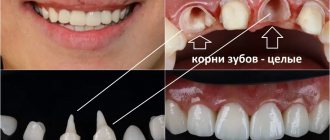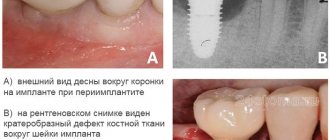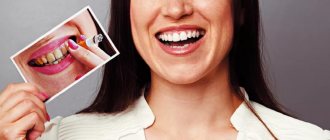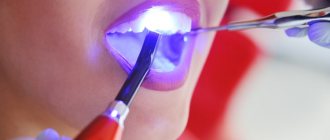Basic oral hygiene products
The main means of oral hygiene primarily include toothbrushes, the varieties and configuration of which we will consider below:
Toothbrushes
There are two types of these devices: conventional (manual) and electric. Regardless of what type of toothbrush it is, one of the main criteria for choosing it is the bristles.
Bristles by degree of hardness
- Hard (super hard). It is used strictly on the recommendation of a dentist and is especially suitable for people susceptible to excessive tartar formation. In addition, stiff bristles may be suitable for cleaning dentures;
- Medium hardness. It is considered a classic option, suitable for almost everyone without any restrictions. It is also well suited for the care of orthodontic structures and dentures;
- Soft. Recommended for use by children, as well as people suffering from bleeding gums and increased sensitivity of tooth enamel;
- Super soft. The use of such toothbrushes may be recommended by the attending physician based on the individual characteristics of the patient.
The bristles of toothbrushes are
- Natural. Made from animal guard hair. The main disadvantage of such bristles is their rapid wear and tear;
- Synthetic. Made from safe synthetic materials. It is distinguished by its long-term preservation of its qualities and ease of processing, guaranteeing the removal of contaminants after use.
In addition to the above, it is worth paying attention to the configuration of the bristles:
- Beveled with a slope. Allows you to most thoroughly remove plaque, including from the distant molars;
- Multi-level bristles. Allows you to remove food particles and plaque not only from the surface of the teeth, but also from the interdental crevices;
- Collected in bunches. Allows you to increase the coverage area, which also includes the necks of the teeth.
In addition to the main selection criteria listed above, it is also worth paying attention to the size of the cleaning head and its mobility. Movable heads are suitable for people who should avoid excessive pressure on teeth, gums, or orthodontic structures installed in the oral cavity to avoid damage.
Choosing an Electric Toothbrush
In addition to the main criterion, which is bristles, when choosing an electric toothbrush, you need to pay attention to:
- The shape of the cleaning head. They are round and elongated;
- Ability to change speed modes;
- Possibility of changing the direction of rotation;
- Mode type: ultrasonic, sonic, or ionization.
It is worth noting that it is advisable to use an electric toothbrush only after prior consultation with a dentist, who will help you choose the most suitable option.
Regardless of the type of toothbrush, replacement with a new one is carried out no later than 3 months from the start of use. Manual brushes must be completely replaced, and for electric brushes, the cleaning attachment must be replaced.
Toothpastes
All toothpastes are divided into three main groups:
- Hygienic. Designed for everyday oral hygiene;
- Therapeutic and prophylactic. The composition of such pastes includes components,
- Specialized. The use of this type of toothpaste is prescribed by the attending physician and is necessary to maintain the therapeutic effect achieved by the main treatment. The composition of such pastes includes medicinal components;
- Whitening. Pastes with a whitening effect contain abrasive particles and can whiten enamel by 1-1.5 tones. However, long-term use of whitening toothpastes is not recommended due to the risk of enamel damage.
Having a preventive and not pronounced therapeutic effect. As a rule, herbal preparations or formulations enriched with fluorine and calcium are used as specialized additives;
Choosing toothpaste
First of all, buy only toothpastes that contain fluoride. This substance makes the outer layer of enamel stronger. However, there are many people who have an allergic reaction to it. There are also a number of other medical contraindications. In such a situation, you will have to choose a paste with a different composition. But in any case, before purchasing a cleaning product, consult a specialist.
Similar recommendations apply when choosing children's toothpaste. It is important that it tastes good.
Also take into account the sensitivity of your teeth. Special pastes are produced for teeth with increased sensitivity. If you want to whiten your enamel, choose bleaching compounds.
Additional oral hygiene products
In addition to the main ones, there are also additional oral hygiene products , in combination with which you can fully care for the health of your teeth and gums.
Dental floss
Dental floss is a means for daily use, but cannot act as a replacement for a toothbrush. The main function of floss is to remove food debris and soft plaque from the interdental spaces. Although dental floss is not a basic means of hygiene, its importance cannot be underestimated, since its use is an important factor in the prevention of caries. Accumulating in interdental spaces inaccessible to a toothbrush, food debris and dental plaque become a favorable environment for the accumulation of bacteria, which in turn leads to the development of caries. This is why flossing is most important after meals, or in cases where a toothbrush is not available. Types of dental floss:
- Round. Universal floss, suitable for interdental gaps of any size;
- Flat. Necessary for people with tightly-fitting teeth and, accordingly, narrow spaces between dental units;
- Tape. Universal threads, but their use is most advisable in case of large distances between teeth;
- Volumetric. They are characterized by the ability to swell under the influence of saliva, which makes them most productive in terms of removing contaminants.
In addition to the above, dental flosses have differences in the impregnation applied to them. There is a wide variety of processing compounds aimed at:
- Facilitation of thread sliding (waxing);
- Elimination of unpleasant odor and creation of aftertaste (menthol);
- Disease prevention (fluoridated);
- Elimination of bacteria (antiseptic).
However, it is necessary to take into account that despite the large number of advantages, dental floss also has a number of contraindications. Thus, their use is not advisable for people who have orthodontic structures, increased bleeding gums or advanced forms of caries.
Irrigators
An irrigator is a device that cleanses the oral cavity using a pulsating stream of water directed under high pressure. Types of irrigators:
- Portable. They are battery operated and have a pressure control function;
- Stationary. Attached directly to the wall, or any horizontal surface;
- Flow-through. They work by connecting to the water supply system.
- Mechanical. The work is carried out by a pump that pumps up water.
The pressure is adjusted using the water supply valve;
It must be taken into account that the irrigator is not a replacement for a toothbrush, but is an auxiliary one. The use of an irrigator will be most appropriate for people who have orthodontic structures installed and increased gum bleeding. The latter is related to the massaging ability of the irrigator.
Chewing gum
The use of chewing gum as a means of oral hygiene will be justified only if it is done without abuse. It is important to know that chewing gum can be both beneficial and harmful. Dentists recommend chewing gum for no more than 5 minutes and strictly after eating. In this case, chewing gum will help:
- Remove food residues;
- Stimulate digestion and the production of saliva, which is a natural cleanser and eliminates a number of bacteria from the oral cavity;
- Freshen your breath. It is worth remembering that chewing gum does not fight the unpleasant odor, the source of which is most often bacteria, but only masks it;
- Provide a massaging effect on the gums;
- Create a relaxing effect that reduces excitability.
Uncontrolled and prolonged use of chewing gum can lead to a number of negative consequences:
- Periodontal fatigue;
- Thinning of tooth enamel;
- Overstrain of masticatory muscles and ligaments;
- Disturbances in the functioning of the gastrointestinal tract;
- Ingestion of bacteria removed from the surface of the teeth.
Rinse aids and foams
These products help to consolidate the results achieved by cleaning with a toothbrush. These products not only freshen breath, but are also able to create a thin protective film on the surface of the teeth that prevents the accumulation of bacteria. Thus, the use of these products is not an alternative to a toothbrush or floss, but it is advisable to use them after every meal and before bed.
Despite the presence of a large number of modern oral hygiene products available in everyday life, at least once a year it is necessary to visit a dentist who will carry out professional teeth cleaning. Even regular use of the hygiene products listed above cannot guarantee the absence of the formation of hard dental plaque, which only a doctor can remove.
Tongue brushes
After brushing your teeth, you need to remove plaque from the back of your tongue. Special mechanical brushes made of plastic or metal remove food debris and opportunistic microflora - this eliminates bad breath.
How to use: Place the brush as close to the root of the tongue as possible and, using light pressure, move it forward. The procedure is recommended to be carried out in the evening before going to bed, because plaque accumulated during the day contributes to the proliferation of bacteria, the development of caries and gum disease.
Normally, the oral cavity is inhabited by microorganisms that participate in the primary breakdown of food, preserve enamel and maintain the general microflora of the body. When the balance of microflora is disturbed, colonies of pathogenic bacteria are formed, which destroy enamel and affect periodontal tissue.
Therefore, you need to clean your mouth from food debris and bacteria every day. This prevents not only dental pathologies, but also diseases of the gastrointestinal tract associated with them. Well-groomed teeth make your face attractive in the eyes of others.
Previous tip Return to tips Next tip
Professional teeth cleaning at the dentist
Professional teeth cleaning includes:
- Removal of hard dental plaque using an ultrasonic device or laser;
- Lightening of tooth enamel using modern gentle AIRFLOW technology;
- Polishing enamel using professional products;
- Treatment with fluoridating compounds that strengthen the enamel;
- Sealing of fissures using resins. This procedure is necessary to protect teeth from carious lesions.
It is important to remember that a healthy oral cavity is not only an aesthetically attractive appearance, but also a guarantee of the health of the body as a whole. Proper oral hygiene and regular visits to the dentist will help maintain the physiologically normal condition of teeth.
Description of the irrigator
This modern device is also designed for cleaning interdental spaces and hard-to-reach areas. Its action is to direct a stream of water to areas that require cleaning. An irrigator is quite an expensive thing, but its use can effectively clean teeth from stuck food, plaque and bacteria. Unlike dental floss, a brush for cleaning teeth or a toothpick, it is impossible to damage the gums with an irrigator. Using an irrigator is absolutely safe for enamel and gums. Modern irrigators are the best alternative to all devices for cleaning hard-to-reach places between teeth.
Choosing dental floss
If you want to keep your teeth healthy, daily flossing is a must. This oral hygiene product can have different thicknesses and shapes. Threads are also available in different flavors and types of coatings.
Wrap the floss around your fingers and insert it into the space between your teeth. It should envelop the dental crown in a C-shape. To effectively remove plaque, you need to move the thread not only back and forth, but also up and down. Use extreme caution when brushing your gum line—too harsh movements can cause tissue damage.
For more reliable fixation of the thread, you can use special holders sold in almost any pharmacy. They are also sold in many grocery stores. Holders are available in bright colors for children.
A child should floss only under adult supervision. The best time for this procedure is the evening - before bed. But this is not important, and you can do it whenever it is convenient for you.
